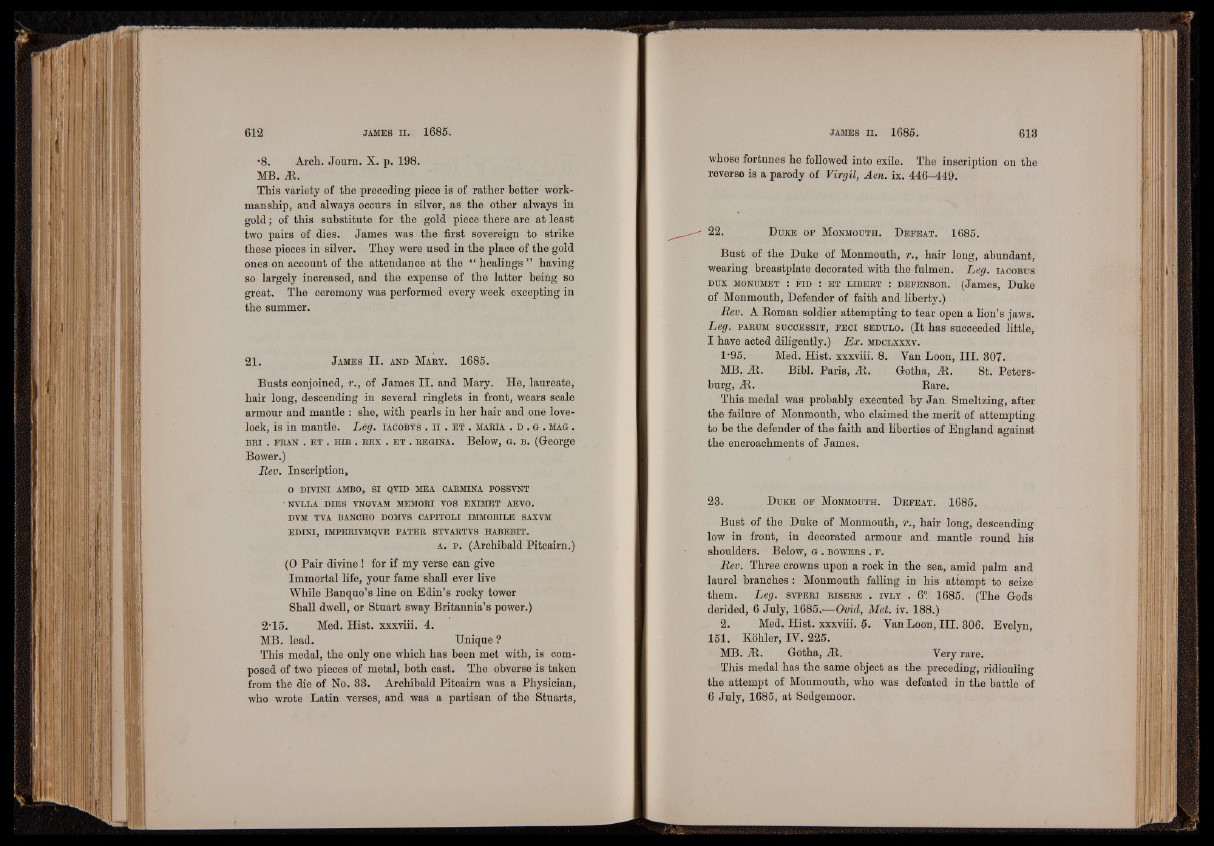
•8. Arch. Journ. X. p. 198.
MB. At.
This variety of the preceding piece is of rather better workmanship,
and always occurs in silver, as the other always in
gold; of this substitute for the gold piece there are at least
two pairs of dies. James was the first sovereign to strike
these pieces in silver. They were used in the place of the gold
ones on account of the attendance at the “ healings ” having
so largely increased, and the expense of the latter being so
great. The ceremony was performed every week excepting in
the summer.
21. J am e s II. and M a ry . 1685.
Busts conjoined, r., of James I I . and Mary. He, laureate,
hair long, descending in several ringlets in front, wears scale
armour and mantle : she, with pearls in her hair and one lovelock,
is in mantle. Leg. iacobvs . i i . e t . m ae ia . d . g . mag .
BEI . FRAN . ET . HIB . EEX . ET . REGINA. Below, G. B. (George
Bower.)
Rev. Inscription,
o DIVINI AMBO, SI QVID MEA CAEMINA POSSVNT
' NVLLA DIES VNQVAM MEMOEI VOS EXIMET AEVO.
DVM TVA BANCHO DOMVS CAPITOLI IMMOBILE SAXVM
EDINI, IMPEEIVMQVE PATEE STVARTVS HABEBIT.
a . p. (Archibald Pitcairn.)
(0 Pair divine ! for if my verse can give
Immortal life, your fame shall ever live
While Banquo’s line on Edin’s rocky tower
Shall dwell, or Stuart sway Britannia’s power.)
2’15. Med. Hist, xxxviii. 4.
MB. lead. Unique ?
This medal, the only one which has been met with, is composed
of two pieces of metal, both cast. The obverse is taken
from the die of No. 83. Archibald Pitcairn was a Physician,
who wrote Latin verses, and was a partisan of the Stuarts,
whose fortunes he followed into exile. The inscription on the
reverse is a parody of Virgil, Aen. ix. 446—449.
22. D u k e o f M o nm o u t h . D e f e a t . 1685.
Bust of the Duke of Monmouth, r., hair long, abundant,
wearing breastplate decorated with the fulmen. Leg. iacobus
d u x m on um e t : f id : e t l ib e e t : d e f e n s o e . (James, Duke
of Monmouth, Defender of faith and liberty.)
Rev. A Roman soldier attempting to tear open a lion’s jaws.
Leg. parum su c c e s s it , f e c i s e d u l o . (It has succeeded little,
I have acted diligently.) Ex. mdclxxxv.
1*95. Med. Hist, xxxviii. 8. Van Loon, III. 307.
MB. At. Bibl. Paris, At. Gotha, At. St. Petersburg,
At. Bare.
This medal was probably executed by Jan Smeltzing, after
the failure of Monmouth, who claimed the merit of attempting
to be the defender of the faith and liberties of England against
the encroachments of James.
23. D u k e o f M o nm o u th . D e f e a t . 1685.
Bust of the Duke of Monmouth, r., hair long, descending
low in front, in decorated armour and mantle round his
shoulders. Below, g . b ow e r s . f .
Rev. Three crowns upon a rock in the sea, amid palm and
laurel branches: Monmouth falling in his attempt to seize
them. Leg. s v p e r i r i s e r e . iv l y . 6° 1685. (The Gods
derided, 6 July, 1685.—Ovid, Met. iv. 188.)
2. Med. Hist, xxxviii. 5. Van Loon, III. 306. Evelyn,
151. Köhler, IV. 225.
MB. At. Gotha, At. Very rare.
This medal has the same object as the preceding, ridiculing
the attempt of Monmouth, who was defeated in the battle of
6 July, 1685, at Sedgemoor.